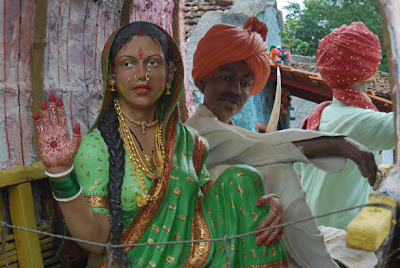India dwells in her villages- Gandhi
Scattered throughout India are approximately 500,000 villages. The Census of India regards most settlements of fewer than 5,000 as a village. These settlements range from tiny hamlets of thatched huts to larger settlements of tile-roofed stone and brick houses. Most Indian villages are small; nearly 80 percent have fewer than 1,000 inhabitants, according to the 1991 census. Most are nucleated settlements, while others are more dispersed. It is in villages that India's most basic business--agriculture--takes place. Here, in the face of vicissitudes of all kinds, farmers follow time-tested as well as innovative methods of growing wheat, rice, lentils, vegetables, fruits, and many other crops in order to accomplish the challenging task of feeding themselves and the nation. Here, too, flourish many of India's most valued cultural forms.
Viewed from a distance, an Indian village may appear deceptively simple. A cluster of mud-plastered walls shaded by a few trees, set among a stretch of green
or dun-colored fields, with a few people slowly coming or going, oxcarts creaking, cattle lowing, and birds singing--all present an image of harmonious simplicity. Indian city dwellers often refer nostalgically to "simple village life." City artists portray colorfully garbed village women gracefully carrying water pots on their heads, and writers describe isolated rural settlements unsullied by the complexities of modern urban civilization. Social scientists of the past wrote of Indian villages as virtually self-sufficient communities with few ties to the outside world.
In actuality, Indian village life is far from simple. Each village is connected through a variety of crucial horizontal linkages with other villages and with urban areas both near and far. Most villages are characterized by a multiplicity of economic, caste, kinship, occupational, and even religious groups linked vertically within each settlement.
(The above article has been taken from Cyber Essays)
My friend Sita Henderson emailed me photos of the Siddhagiri Wax Museum depicting an Indian village in South India. I never knew India too had a wax museum and such a good one too. I found their website . You can read more about the museumHERE HERE.
Modernization has reached most Indian villages , so the methods of agriculture and living are not as ancient as seen here - although there are pockets of neglect and backwardness.
Modern machinery and farming expertise is freely available. The electrified villages have satilite television, Internet and mobile phone services. Agriculturists in the western part of my state are very wealthy.
At the same time progress and modernization has to reach everyone equally. There are many parts who have yet to see the sun of prosperity rise over them.
The figures of the wax museum are very life like and skillfully crafted. They show the cultural, social, religious and agricultural aspects of Indian villages.
Scattered throughout India are approximately 500,000 villages. The Census of India regards most settlements of fewer than 5,000 as a village. These settlements range from tiny hamlets of thatched huts to larger settlements of tile-roofed stone and brick houses. Most Indian villages are small; nearly 80 percent have fewer than 1,000 inhabitants, according to the 1991 census. Most are nucleated settlements, while others are more dispersed. It is in villages that India's most basic business--agriculture--takes place. Here, in the face of vicissitudes of all kinds, farmers follow time-tested as well as innovative methods of growing wheat, rice, lentils, vegetables, fruits, and many other crops in order to accomplish the challenging task of feeding themselves and the nation. Here, too, flourish many of India's most valued cultural forms.
Viewed from a distance, an Indian village may appear deceptively simple. A cluster of mud-plastered walls shaded by a few trees, set among a stretch of green
or dun-colored fields, with a few people slowly coming or going, oxcarts creaking, cattle lowing, and birds singing--all present an image of harmonious simplicity. Indian city dwellers often refer nostalgically to "simple village life." City artists portray colorfully garbed village women gracefully carrying water pots on their heads, and writers describe isolated rural settlements unsullied by the complexities of modern urban civilization. Social scientists of the past wrote of Indian villages as virtually self-sufficient communities with few ties to the outside world.
In actuality, Indian village life is far from simple. Each village is connected through a variety of crucial horizontal linkages with other villages and with urban areas both near and far. Most villages are characterized by a multiplicity of economic, caste, kinship, occupational, and even religious groups linked vertically within each settlement.
(The above article has been taken from Cyber Essays)
My friend Sita Henderson emailed me photos of the Siddhagiri Wax Museum depicting an Indian village in South India. I never knew India too had a wax museum and such a good one too. I found their website . You can read more about the museumHERE HERE.
Modernization has reached most Indian villages , so the methods of agriculture and living are not as ancient as seen here - although there are pockets of neglect and backwardness.
Modern machinery and farming expertise is freely available. The electrified villages have satilite television, Internet and mobile phone services. Agriculturists in the western part of my state are very wealthy.
At the same time progress and modernization has to reach everyone equally. There are many parts who have yet to see the sun of prosperity rise over them.
The figures of the wax museum are very life like and skillfully crafted. They show the cultural, social, religious and agricultural aspects of Indian villages.
Ploughing a field.
Drawing water
Many areas have water scarcity.
Wells come in use.
Indian agriculture suffers quite a bit
as it depends on the monsoons
and natural rain for irrigation.
A village barber.
They are found in the city too.
A village astrologer or Pundit
is an important man to be
consulted about various activities of life.
Horoscopes and auspicious dates have to be
determined.
I am not sure but this one could
be showing the ancient oil press.
The oxen move round operating
the oil press.
Of course now we have the electric ones.
The bangle lady goes from house to house
selling her wares and putting on multi colored
glass bangles on ladies.
Married women must wear bangles.
Bare wrists are not considered nice.
This young woman nurses her baby
while the bangle lady obliges her.
The Potter
Hand operated machine.
I am not sure what is its purpose.
Someone can apprise me.
Cattle byre
Vegetable shop
Make stone ware objects and utensils
Basket weavers
Seamstress
A typical money lender.
They are very shrew d and ambitious men
and poor unsuspecting peasants are cheated by them.
A herbalist , apothecary or
ayurvedic physician.
They use various herbs,oils and massages
to treat their patients.
A gold and silver smith.
Gold and silver ornaments are
the pride an d joy of an Indian woman.
Even the poorest of the poor must have some
thing of value to boast of.
A grocery store.
A family relaxing together
Singing a religious song for a festival.
Iron forge
Farrier
Making metal utensils.
A visit to the temple
with articles of pooja.
A woman displaying her henna tattoos.
Its customary to have them applied for
festivals and weddings.
The village council or panchayat.
It plays a very important role
in keeping l;aw and order at the grass root level and
settling petty disputes.
Five village elders and voted into this governing body.
They are given judicial rights by the government.
This was a little glimpse of
an Indian village.
This museum ha s tried to preserve
the older traditional senario.
Hope you liked it.
++++++++++++++++++
Thank you for your prayers for me and my church.
The Lord 's hand of grace and mercy is upon us.






































11 Fertilize my soul:
What an interesting post on village life in your country. I would go to the herbalist, apothecary or ayurvedic physician. We do take herbs, use essential oils and know that they and massages do work.
Thanks for posting this Amrita.
FlowerLady
dear amrita...i am so glad that i get an email when you have written a post so that now i know right away!
i read this out loud as bernie and i sat together and it is sooooo interesting...you have done a great job in holding my interest.
when i was in high school i did not like geography class but i am sure if you had been the teacher, i would have LOVED it and probably got better marks!
thanks so much for spending all this work to educate us about the wonders of india and the beautiful people that live there...love terry
Amrita, your photos a fantastic! The museum looks like a very interesting place to visit.
Gandhi must be one of the most quoted people who ever lived.
Hi Amrita,
This series of photos from the wax museum is one of the most interesting you've ever posted!
John
Dear Amrita,
What a fascinating post! It has a great deal of amazing information, and the photos are neat. I would like to visit the museum. I've never seen a museum of that size.
Thanks for stopping by. I always enjoy your sweet comments.
(((( hugs )))))
Doris
Dear Amrita,
The wax museum is a great tribute to the Indian villages and primer culture.
Skillfully crafted and informative to the rest of the world.
My guess is that the picture of the wheel and the two men working is kind of a small yarn spinning factory,a long way from Gandhi's primitive spindle.
Then again, I may be wrong, as I often tend to. Weaving, perhaps?
Thank you for your informative post. One among many great ones.
From Felisol
It was for me journey to different world. Villages on whole world are similar - people must hard work, very often they are poor - I respect work of farmers. People from villages have also their own culture and style of thinking - I think they are often very wise because of their experiences.
That's an old weaving machine normally for weaving cotton clothing material. The wax figures look so impressive and depict various scenes and lifestyles in rural India. Thanks for the post. God bless you always.
WOW! Amazing! You know I love your "India Uncut" the most. So, are many of the displays at this museum actually situated outdoors? In those cases, are the figures still made of wax?
Dear friends thank you so much for your comments.
Akthough modernization has reached most places, remote unreachable areas remain. ..thos e inhabited by tribals too. The government has to do a lot more fo r them.
Education an d social reform is badly needed.
Thank you telling me wha t that machine is. A spinning machine.
Hi Kate, yeah it sn amazing place and looks like some of it is out doors. They claim to be wax sculptures - the website says that. i was also wondering how they mantain the open air exhibits.
Post a Comment